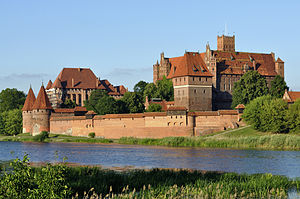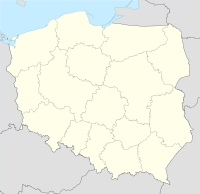- Malbork Castle
-
Malbork Castle (Ordensburg Marienburg) Zamek w Malborku Part of Pomeranian Voivodeship, Poland Malbork 
The castle from across the River NogatCoordinates 54°02′23″N 19°01′40″E / 54.03972°N 19.02778°ECoordinates: 54°02′23″N 19°01′40″E / 54.03972°N 19.02778°E The Marienburg Castle in Malbork (Polish: Zamek w Malborku, German: Ordensburg Marienburg) is by area [1] the largest castle in the world. It was built in Prussia by the Teutonic Knights, a German Roman Catholic religious order of crusaders, in a form of an Ordensburg fortress. The Order named it Marienburg (Mary's Castle). The town which grew around it was also named Marienburg.
The castle is a classic example of a medieval fortress, and on its completion in 1406 was the world's largest brick castle.[2] UNESCO designated the "Castle of the Teutonic Order in Malbork" and its Museum as the World Heritage Site in December 1997.[3] It is one of two World Heritage Sites in the region with origins in the Teutonic Order. The other is the "Medieval Town of Toruń", founded in 1231 as the site of the castle Thorn (Toruń).
Contents
History
The castle was founded by the Teutonic Order after the conquest of Old Prussia. Its main purpose was to strengthen their own control of the area following the Order's 1274 suppression of the Great Prussian Uprising of the Baltic tribes. No contemporary documents survive relating to its construction, so instead the castle's phases have been worked out through the study of architecture and the Order's administrative records and later histories. The work lasted until around 1300, under the auspices of Commander Heinrich von Wilnowe.[4] The castle is located on the southeastern bank of the river Nogat. It was named Marienburg after Mary, patron saint of the religious Order. The Order had been created in Acre (present-day Israel). When this last stronghold of the Crusades fell to Muslim Arabs, the Order moved its headquarters to Venice before arriving in Poland.
Malbork became more important in the aftermath of the Teutonic Knights' conquest of Gdańsk (Danzig) and Pomerania in 1308. The Order's administrative centre was moved to Malbork from Elbląg (Elbing). The Grand Master of the Teutonic Knights, Siegfried von Feuchtwangen, who arrived in Malbork from Venice, undertook the next phase of the fortress' construction.[4] In 1309, in the wake of the papal persecution of the Knights Templar and the Teutonic takeover of Danzig, Feuchtwangen relocated his headquarters to the Prussian part of the Order's monastic state. He chose the site of Marienburg conveniently located on the Nogat in the Vistula Delta. As with most cities of the time, the new centre was dependent on water for transportation.
The castle was expanded several times to house the growing number of Knights. Soon, it became the largest fortified Gothic building in Europe,[5] on an nearly 52-acre (21 ha) site. The castle has several subdivisions and numerous layers of defensive walls. It consists of three separate castles - the High, Middle and Lower Castles, separated by multiple dry moats and towers. The castle once housed approximately 3,000 "brothers in arms". The outermost castle walls enclose 52 acres (21 ha), four times the acreage of the enclosed space of Windsor Castle. The developed part of the property designated as a World Heritage Site is 18.038 ha (44.57 acres).[6]
 Vorburg with rampart added under Hochmeister Heinrich von Plauen, 15th century
Vorburg with rampart added under Hochmeister Heinrich von Plauen, 15th century
The favourable position of the castle on the river Nogat allowed for easy access by barges and trading ships arriving from the Vistula and the Baltic Sea. During their governance, the Teutonic Knights collected river tolls from passing ships, as did other castles along the rivers. They controlled a monopoly on the trade of amber. When the city became a member of the Hanseatic League, many Hanseatic meetings were held there.
In the summer of 1410, the castle was besieged following the Order's defeat by the armies of Władysław II Jagiełło and Vytautas the Great (Witold) at the Battle of Grunwald. Heinrich von Plauen successfully led the defence in the Siege of Marienburg (1410), during which the city outside was razed.
In 1456, during the Thirteen Years' War, the Order – deserted and opposed for raising taxes to pay ransoms for their own mercenaries taken by the Kingdom of Poland – could no longer manage financially. Meanwhile, Polish General Stibor de Poniec of Ostoja raised funds from Danzig for a new campaign against them. Learning that the Order's Bohemian mercenaries had not been paid, Stibor convinced them to leave. He reimbursed them with money raised in Danzig.[7] Following the departure of the mercenaries, King Casimir IV Jagiellon entered the castle in triumph in 1457, and in May, granted Danzig several privileges in gratitude for the town's assistance and involvement in the Thirteen Years' War (1454–66) as well as for the funds collected for the mercenaries that left.[8]
Marienburg mayor Bartholomäus Blume resisted the Polish forces for three more years, but the Poles captured and hanged him in 1460. A monument to Blume was erected in 1864.[9] In 1466 both castle and town became part of Royal Prussia. It served as one of the several Polish royal residences. During the Thirty Years' War, in 1626 and 1629 Swedish forces occupied the castle. They invaded and occupied it again 1656 to 1660 during the Northern Wars.
After the Partitions of Poland
 Castle in 1890/1905, during the German Empire
Castle in 1890/1905, during the German Empire
After Prussia and the Russian Empire made the First Partition of Poland in 1772, the town became part of the Kingdom of Prussia province of West Prussia. At that time, the officials used the rather neglected castle as a poorhouse and barracks for the Prussian Army. In 1794 David Gilly, a Prussian architect and head of the Oberbaudepartement, made a structural survey of the castle, to decide about its future use or demolition. Gilly's son, Friedrich Gilly, produced several engravings of the castle and its architecture, which he exhibited in Berlin and had published by Friedrich Frick from 1799 to 1803. These engravings led the Prussian public to "rediscover" the castle and the history of the Teutonic Knights.[10]
Johann Dominicus Fiorillo published another edition of the engravings on 12 February 1803, also wanting to encourage public interest. Max von Schenkendorf critizised the defacement of the castle. Throughout the Napoleonic period, the army used the castle as a hospital and arsenal. After Prussia was liberated again, the castle became a symbol of Prussian history and national consciousness. Initiated by Theodor von Schön, Oberpräsident of West Prussia, in 1816, restoration of the castle was begun.[11] It was undertaken in stages until World War II started.[12]
With the rise of Adolf Hitler to power in the early 1930s, the Nazis used the castle as a destination for annual pilgrimages of both the Hitler Youth and the League of German Girls. The Teutonic Castle at Marienburg served as the blueprint for the Order Castles of the Third Reich built under Hitler's reign.[13] In 1945 during World War II combat in the area, more than half the castle was destroyed.
At the conclusion of the war, the city of Marienburg (Malbork) and castle became part of Poland. The castle has been mostly reconstructed, with restoration ongoing since 1962 following a fire in 1959 which caused further damage. The main cathedral in the castle, restored just before World War II and then destroyed in battle, is still in ruins.
Panoramic image of Malbork Castle from the Northwestern bank of the river Nogat Burials in the mausoleum under the Chapel of St. Anne
- Dietrich von Altenburg
- Heinrich Dusemer
- Winrich von Kniprode
- Conrad Zöllner von Rothenstein
- Konrad von Jungingen
- Michael Küchmeister von Sternberg
- Konrad von Erlichshausen
See also
- Trakai Island Castle, similar architecture
References
- Notes
- ^ Malbork Castle (with an area of 143,591 square meters), the largest castle in the world by KML Area Calculator. Touropia, the Travel List Website: "10 Largest Castles in the World." Accessed 6 April 2011.
- ^ Emery 2007, p. 139
- ^ Castle of the Teutonic Order in Malbork, World Heritage Site. ID 847. Year 1997 UNESCO, Europe and North America
- ^ a b Emery 2007, p. 143
- ^ Medieval History for Dummies By Stephen Batchelor. Page 363 ISBN 0470747838.
- ^ "Castle of the Teutonic Order in Malbork", WHC-08/32.COM/8D, UNESCO, Paris, 22 May 2008.
- ^ [www.poniec.pl http://www.poniec.net/index.php?option=com_content&task=view&id=26&Itemid=45, As per Antoni Eckstein, History of Poniec,] published in "Roczniki Historyczne", v.II, p.92 of IH PAN (Intitute of History, Polish Academy of Science), 1926
- ^ Andrzej Nowak and Dariusz Osowski, Królewski herb Gdańska, Album Polski.pl
- ^ Matthias Weber: Preussen in Ostmitteleuropa: Geschehensgeschichte und Verstehensgeschichte, 2003
- ^ Boockman 1992, p. 344
- ^ C. Steinbrecht, Schloss Marienburg in Preussen, Berlin, 1894
- ^ Boockman 1992, pp. 36–40
- ^ Shirer 1960, pp. 255–256
- Bibliography
- Boockmann, Hartmut (1992), "Deutsche Geschichte im Osten Europas" (in German), Ostpreußen und Westpreußen, Berlin, ISBN 3-88680-212-4
- Emery, Anthony (2007), "Malbork Castle – Poland" (PDF), The Castle Studies Group Journal 21: 138–156, http://www.castlestudiesgroup.org.uk/Malbork%20-%20Anthony%20Emery.pdf
- Shirer, William (1960), The Rise and Fall of the Third Reich, Simon & Schuster, ASIN B000EA3XL4
Further reading
External links
- Malbork Castle Museum
- "Malbork", Castles of Poland
- The Malbork Castle Virtual Tour
World Heritage Sites in Poland Auschwitz-Birkenau German Nazi Concentration and Extermination Camp (1940–1945) · Białowieża Forest / Belovezhskaya Pushcha (with Belarus) · Castle of the Teutonic Order in Malbork · Centennial Hall, Wrocław · Churches of Peace in Jawor and Świdnica · Cracow's Historic Centre · Kalwaria Zebrzydowska: the Mannerist Architectural and Park Landscape Complex and Pilgrimage Park · Park Muzakowski / Muskauer Park (with Germany) · Medieval Town of Toruń · Historic Centre of Warsaw · Wieliczka Salt Mine · Wooden Churches of Southern Lesser Poland · Old City of Zamość

 Categories:
Categories:- World Heritage Sites in Poland
- History of Prussia
- Former castles
- Castles of the Teutonic Knights
- Castles in Poland
- Brick Gothic
- Pomeranian Voivodeship
- Visitor attractions in Poland
- Prussian cultural sites
Wikimedia Foundation. 2010.




